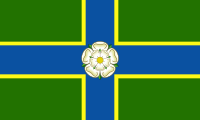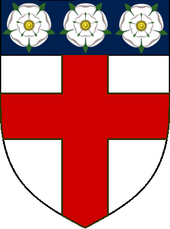North Riding of Yorkshire
The North Riding of Yorkshire is one of the three historic subdivisions (ridings) of the English county of Yorkshire, alongside the East and West ridings. From the Restoration it was used as a lieutenancy area, having been part of the Yorkshire lieutenancy previously. The three ridings were treated as three counties for many purposes, such as having separate quarter sessions. An administrative county was created with a county council in 1889 under the Local Government Act 1888 on the historic boundaries. In 1974 both the administrative county and the Lieutenancy of the North Riding of Yorkshire were abolished, being succeeded in most of the riding by the new non-metropolitan county of North Yorkshire.
| County of York, North Riding | |
|---|---|
 Flag of North Riding (2013) | |
 North Riding shown within England | |
| Area | |
| • 1911 | 1,359,600 acres (5,502 km2) |
| • 1961 | 1,376,607 acres (5,570.93 km2) |
| Population | |
| • 1901 | 286,036 |
| • 1971 | 329,410 |
| History | |
| • Created | 1889 |
| • Abolished | 1974 |
| • Succeeded by | North Yorkshire Cleveland County Durham |
| Status | Riding then Administrative county |
| Chapman code | NRY |
| Government | North Riding County Council (1889-1974) |
| • HQ | Northallerton |
 Coat of arms of North Riding County Council | |
The highest point in the North Riding is Mickle Fell at 2,585 ft (788 metres).
History
Archives from 1808 record that the "north-riding of York-shire" had once consisted of "fifty-one lordships" owned by Robert the Bruce.[1] During the English Civil War, the North Riding predominantly supported the royalist cause, while other areas of Yorkshire tended to support the parliamentarians.[2]
Governance and administration
The County of York, North Riding administrative county was formed in 1889. In 1894 it was divided into municipal boroughs, urban districts and rural districts under the Local Government Act 1894. Middlesbrough had already been incorporated as a municipal borough in 1853 and formed a county borough, exempt from county council control, from 1889. Richmond and Scarborough had been incorporated as municipal boroughs in 1835, with Thornaby-on-Tees added in 1892.
The urban districts in 1894 were Eston, Guisborough, Hinderwell, Kirkleatham, Kirklington cum Upsland, Loftus, Malton, Masham, Northallerton, Pickering, Redcar, Saltburn and Marske by the Sea, Scalby, Skelton and Brotton and Whitby. In 1922 Redcar was incorporated as a borough.
The rural districts in 1894 were Aysgarth, Bedale, Croft, Easingwold, Flaxton, Guisborough, Helmsley, Kirkby Moorside, Leyburn, Malton, Masham, Middlesbrough, Northallerton, Pickering, Reeth, Richmond, Scarborough, Startforth, Stokesley, Thirsk, Wath and Whitby.
County Review Orders reduced the number of urban and rural districts in the county:[3]
- Hinderwell urban district was absorbed by Whitby rural district in 1932
- A new Saltburn and Marske by the Sea urban district was formed from Saltburn by the Sea urban district and part of Guisborough rural district. the remainder of Guisborough RD passed to Loftus urban district and Whitby rural district in 1932
- Kirklington cum Upsland urban district was absorbed by Bedale rural district in 1934
- Masham urban district was redesignated as Masham rural district in 1934
In 1968 a new county borough of Teesside was created, taking in Middlesbrough and parts of the administrative counties of Durham and North Riding. From the North Riding came the boroughs of Redcar and Thornaby-on-Tees, the urban district of Eston, and part of Stokesley rural district (although the remainder of the rural district continued as part of the county). The entirety of Teesside, including the parts north of the River Tees historically in Durham, was associated with the North Riding for lieutenancy and other purposes.
In 1974 the North Riding was abolished as both an administrative county and a Lieutenancy. The majority of its former area became part of the new non-metropolitan county of North Yorkshire, which also includes much of the northern rural part of the West Riding as well as the northern and western fringes of the traditional East Riding. Middlesbrough and Redcar became part of Cleveland and along with the City of York are now in independent unitary authorities which became part of North Yorkshire for ceremonial purposes. The Startforth Rural District (South Teesdale) was transferred to County Durham, becoming part of the Teesdale district, which was subsequently abolished in 2009.
The North Riding is now represented in the districts of Hambleton, Richmondshire, Ryedale, Scarborough, Middlesbrough, and Redcar and Cleveland, and parts in Harrogate district, Stockton-on-Tees (south of the River Tees) and County Durham. The principal towns are Middlesbrough, Redcar, Whitby, Scarborough and Northallerton.[4]
Proposed resurrection of the name in local government
On three occasions a re-use of the name of the North Riding for local government purposes has been considered. During the 1990s UK local government reform, the Banham Commission suggested uniting Richmondshire, Hambleton, Ryedale and Scarborough districts in a new unitary authority called North Riding of Yorkshire. Later, the government proposed renaming the ceremonial county of North Yorkshire the North Riding of Yorkshire.[5] This was deemed inappropriate and rejected, after a "chorus of disapprobation".[6][7]
During a further local government review in the 2000s as part of the preparations for the regional assembly referendums, a unitary authority with the name North Riding of Yorkshire, consisting of Richmondshire, Hambleton, Ryedale and Scarborough was again suggested.[8] However, the Commission withdrew this in favour or two unitary authorities, one for Hambleton and Richmondshire, the other for Ryedale and Scarborough.[9]
Ancient divisions
Unlike most counties in England, which were divided anciently into hundreds, Yorkshire was divided first into three ridings and then into numerous wapentakes within each riding. Within the North Riding of Yorkshire there were thirteen wapentakes in total, as follows:
Wapentakes
|
 Wapentakes |
|
See also
References
- Graves, J. (1808). The History of Cleveland, in the North Riding of the County of York: Comprehending an Historical and Descriptive View of the Ancient and Present State of Each Parish Within the Wapontake of Langbargh; the Soil, Produce, and Natural Curiosities; with the Origin and Genealogy of the Principal Families Within the District. F. Jollie and sons. p. 55. Retrieved 13 June 2020.
Robert de Brus...and fifty-one [lordships] in the north-riding of York-shire;....
- "Historic Cleveland - Timeline". Historic-Cleveland.co.uk. Archived from the original on 30 November 2007. Retrieved 4 October 2007.
- The North Riding of York (Northern Areas) Order 1932, The North Riding of York Review Order 1934
- F. R. Youngs, Local Administrative Units of England, Vol.II, Northern England, London, 1991
- "House of Commons Written Answers to Questions". Parliamentary Debates (Hansard). House of Commons. 1 February 1995. col. 694.
- "House of Commons Written Answers to Questions". Parliamentary Debates (Hansard). House of Commons. 13 February 1995. col. 552.
- "House of Commons Debates". Parliamentary Debates (Hansard). House of Commons. 28 February 1995. col. 993.
- The Boundary Committee for England (December 2003). Draft Recommendations for unitary local government in North Yorkshire (PDF). Archived (PDF) from the original on 19 January 2018. Retrieved 19 January 2018.
- The Boundary Committee for England (May 2004). Final Recommendations for unitary local government in North Yorkshire (PDF). Archived (PDF) from the original on 19 January 2018. Retrieved 19 January 2018.
External links
- Map of the North Riding of Yorkshire on Wikishire
- Information on the North Riding of Yorkshire on I'm From Yorkshire